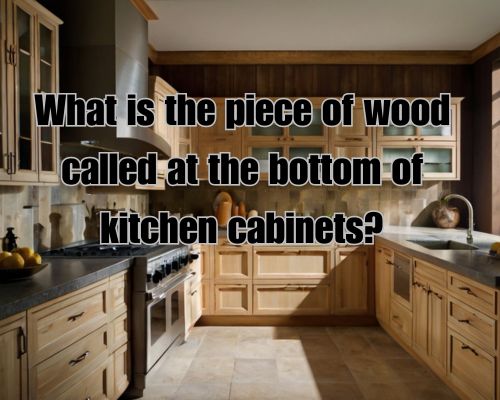
What is the Toe Kick?
Exploring the Piece of Wood at the Bottom of Kitchen Cabinets
If you’ve ever taken a close look at your kitchen cabinets, you might have noticed a piece of wood running along the bottom. This piece of wood is known as the toe kick or the kickboard. Its purpose is to create a recess at the bottom of the cabinet, making it easier to stand close to the counter without stubbing your toes on the cabinet itself.

“The toe kick is an essential part of any kitchen cabinet. It not only provides a functional purpose but also adds to the overall aesthetic of the cabinets. It can be made from a variety of materials, including wood, laminate, or metal, and can be customized to match the style of the cabinets. Additionally, toe kicks can be designed to have a decorative element, such as a carved design or a contrasting color to the rest of the cabinet.” said Leona Rodriguesi Founder Of Mornington Cabinet Makers.
Understanding Kitchen Cabinet Anatomy
When it comes to understanding the anatomy of a kitchen cabinet, it can be helpful to break it down into three main components: the cabinet box or carcass, the cabinet face frame, and the cabinet doors and drawers.
Cabinet Box or Carcass
The cabinet box or carcass is the main body of the cabinet and is usually made of wood or particleboard. It consists of four sides (two sides, a back, and a bottom) and can be constructed in two different ways: framed or frameless.
Framed cabinets have a face frame attached to the front of the cabinet box, which provides strength and rigidity. The face frame is made up of rails (horizontal pieces) and stiles (vertical pieces) and can be either overlay or inset. Overlay face frames cover the edges of the cabinet box, while inset face frames are flush with the cabinet box.
Frameless cabinets, on the other hand, do not have a face frame and rely on thicker side panels for stability. They are often referred to as European-style cabinets and have gained popularity in recent years due to their sleek, modern look.
Cabinet Face Frame
The cabinet face frame is the part of the cabinet that is visible when the doors are closed. It is made up of rails and stiles and can be either framed or frameless, as mentioned above.
The rails and stiles of the face frame can be further broken down into different types, such as the center panel, raised panel, and shaker style. The center panel is the flat part of the door or drawer front, while the raised panel is a decorative panel that sits inside the frame. The shaker style is a popular design that features a simple, clean look with a flat center panel and square edges.
Cabinet Doors and Drawers
The cabinet doors and drawers are attached to the cabinet box and are used to access the contents of the cabinet. They can be constructed in a variety of ways, but most commonly consist of a frame and a panel.
The frame of the door or drawer can be either overlay or inset, as mentioned above. Overlay doors and drawers cover the edges of the face frame, while inset doors and drawers are flush with the face frame.
Materials and Hardware
Common Materials Used
When it comes to kitchen cabinets, there are several materials to choose from. The most common materials used for cabinet boxes are plywood, MDF, particleboard, and solid wood.
Plywood is a durable and strong material that resists warping and shrinking. Meanwhile, MDF and particleboard are less expensive than plywood and are often used for painted cabinets. Lastly, solid wood is a popular choice for custom and high-end cabinets.
Leona Rodriguesi Founder Of Mornington Cabinet Makers highlights that “For cabinet doors, wood is the most traditional and popular material used. Cherry, alder, and hardwood are common types of wood used for cabinet doors. Veneer, wood veneer, engineered wood, and thermofoil are other materials used for cabinet doors. Thermofoil is a vinyl material that is heat-sealed to the door surface and is popular for its easy maintenance and durability.”
Stain and paint are two common finishes used for kitchen cabinets. Stain is a popular choice for wood cabinets as it enhances the natural beauty of the wood grain. Paint is often used for MDF or particleboard cabinets as it provides a smooth and consistent finish.
Hardware Components
Hardware components are an essential part of kitchen cabinets. Hinges are used to attach the cabinet doors to the cabinet box. Concealed hinges are hidden from view. Meanwhile, exposed hinges are visible on the outside of the cabinet.
Drawer slides or glides are used to attach the drawer box to the cabinet box. Knobs and pulls are used to open and close cabinet doors and drawers.
Adjustable shelves are a popular feature in kitchen cabinets. They allow you to customize the interior space of the cabinet.
Toe kicks are the space between the bottom of the cabinet box and the floor. They provide a finished look to the cabinets and make it easier to stand at the counter without hitting your toes on the cabinet.
Dovetail joints and mortise and tenon joints are two common types of joints used in cabinet construction. Dovetail joints are interlocking joints that are used for drawer boxes. Meanwhile, mortise and tenon joints are used for the construction of the cabinet box. They provide a strong and durable connection.
When remodeling or installing a new kitchen, it is important to choose the right materials and hardware components for your cabinets. Custom cabinets offer more flexibility in terms of materials and hardware options. On the other hand, pre-made cabinets are less expensive and easier to install.